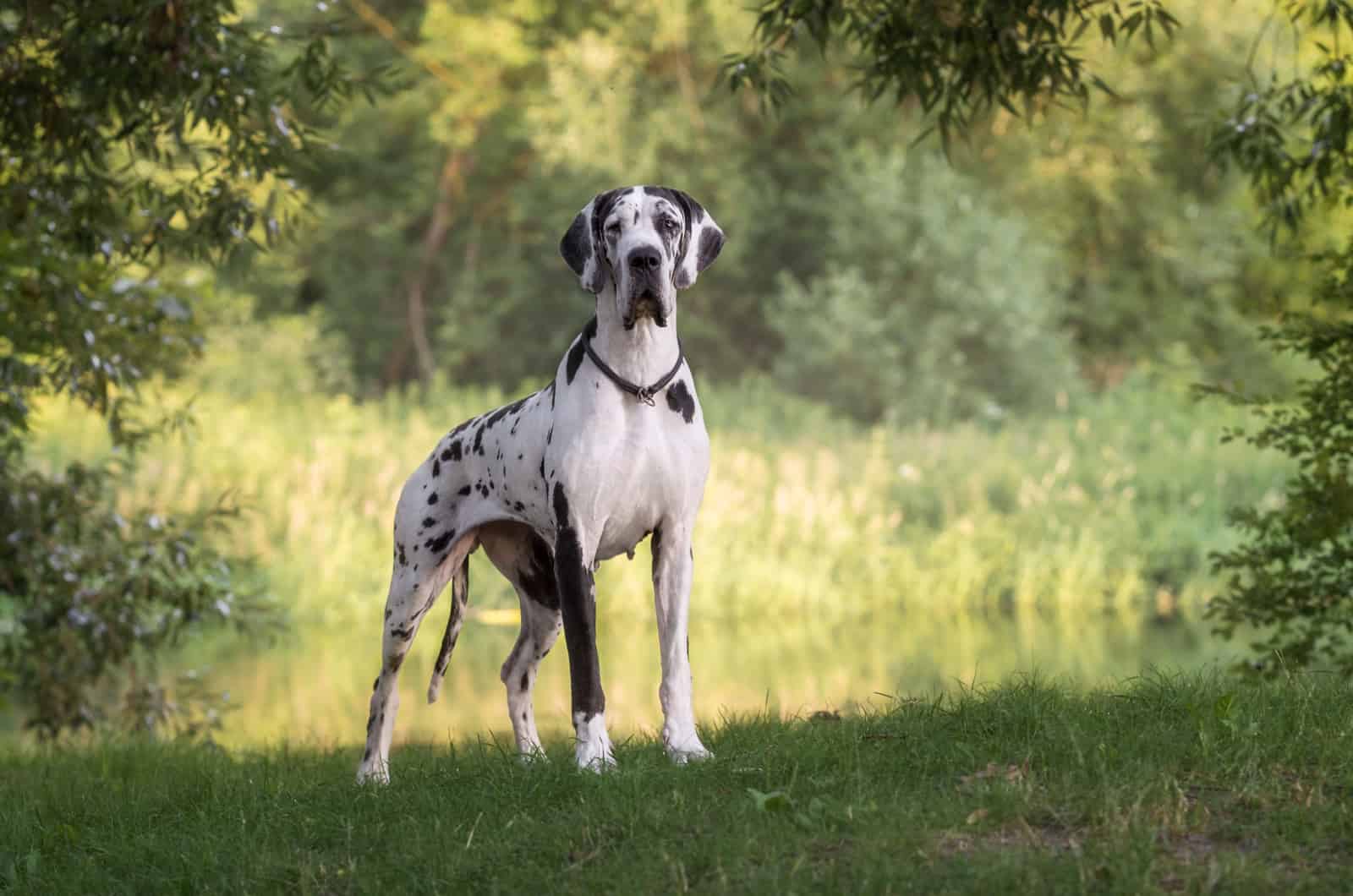No, this is not a huge Dalmatian. The Harlequin Great Dane is the Great Dane that has a different coat color than the regular Danes. This does not affect the Harlequin being a purebred dog. What is characteristic about this Dane, is the merle patches on their coat and skin.
What is specific to this Great Dane dog, is that the Great Dane Colors are usually more monotonous. But our Harlequin’s coat is as beautiful as it is unusual.
It is not just the coat pattern and the color of the skin and fur that is unique to this dog breed. There is a far more deeper explanation for this Great Dane breed, which we will present to you systematically.
What Is A Harlequin Great Dane?
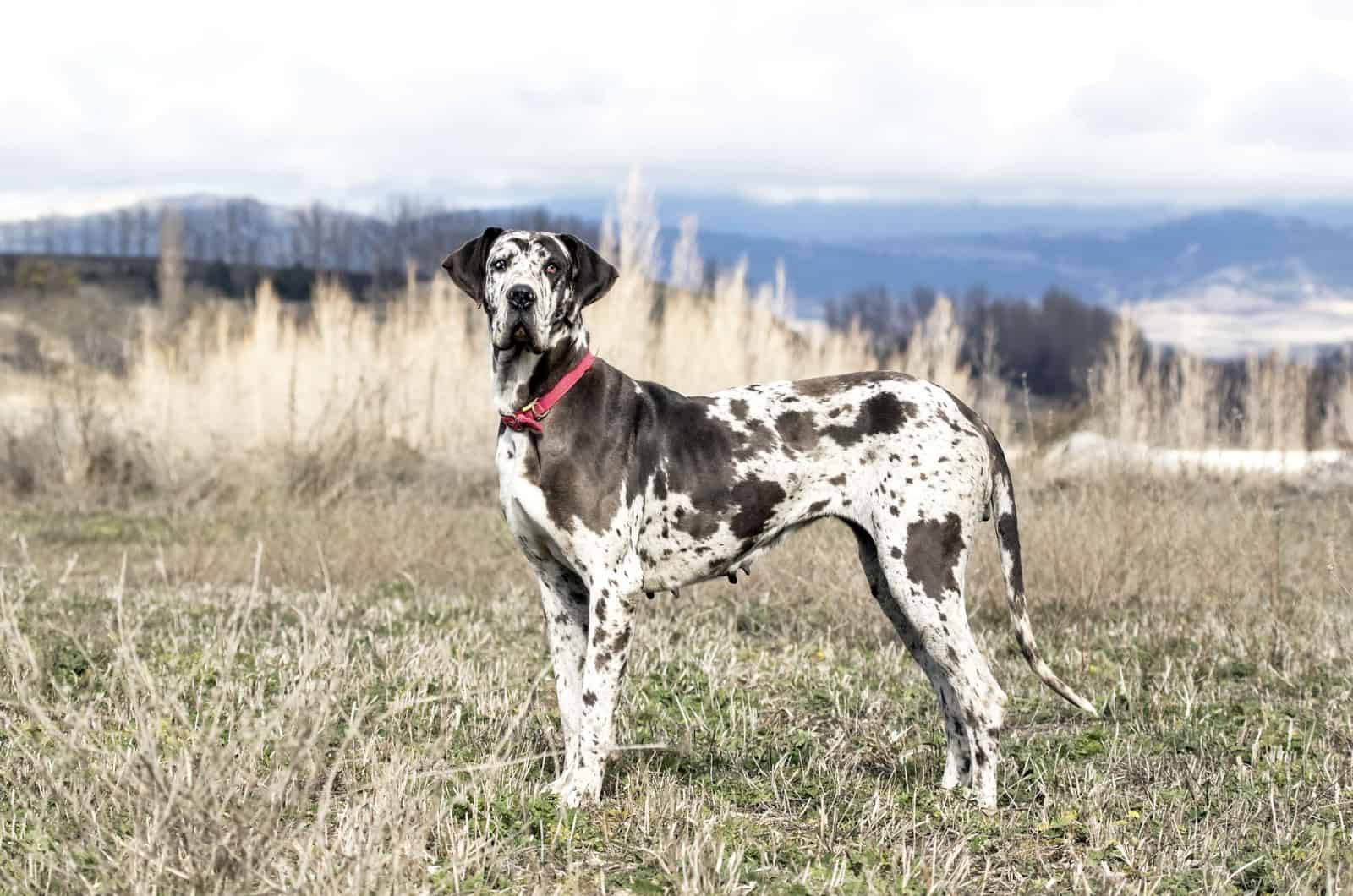
Right off the bet, we can clearly spot the differences between the ‘regular’ purebred Great Dane and the purebred Harlequin Great Dane. The regular Great Danes usually come with a monochromatic coloured coat or, at the most, a two coloured coat.
The Harlequin Dane, the famous dog breed from Lady Gaga’s Poker Face official music video, has grown to be one of the most admired dog breeds.
They are different because of their unique coat, and are breeders’ favourites because of their looks. What distinguishes the Harlequin Dane from others is definitely the irregular, black or grey colour patches on their skin and on their coat.
But how did these skin patches actually start?
Origin Of The Harlequin Great Dane
The origin of Great Danes is from Germany, where they were used as hunters for boars (or the wild pigs). Their athletic bodies and agility is unquestioned, as they are bred to be fast, effective and courageous hunters.
‘Deutsche Dogge’ is what they were originally called in Germany. The English translational equivalent would be something like ‘German Mastiffs’. They were obviously very proud of this canine breed, and wanted to highlight that they are in fact, German dog breeds.
Most of the dog encyclopedias state that these dogs were brought by the Alans, which is a famous Scythian tribe, known for being nomads from the Caucus. Now, that part of the world from which this tribe originates, belongs to Russia.
They were first called German Mastiffs, since they have originated from the Mastiff group of dogs. Mastiffs are an ancient breed known for their hunting and guarding abilities.
It is supposed that the Mastiffs were crossed with the Greyhounds, and therefore making the Great Dane an elegant, sphinx-like dog breed. Some sources also claim that the Great Dane has the genes of the ancient Alaunt in their bloodline.
However, the Harlequin differs from the standard Great Dane. There is a specific factor in the genotype of this specific dog, known as the Merle gene.
Why Do They Have Specific Merle Coat?
The Harlequin Great Dane has a specific Merle coat thanks to the Merle gene. The Merle gene, when appearing in a dog’s genotype, is characteristic for leaving black patches or dark-coloured patches on the dog’s skin and coat.
The Merle Coat is nothing more than a genetic mutation. So, to the question WHY do they have this specific coloured coat, the answer is-thanks to a genetic mutation.
This genetic mutation also affects the eyes of this dog breed. They usually tend to have bright blue eyes, hazel or multi-coloured eyes. It is also not unusual that these dogs have Heterochromia, a medical state that does not affect the eyesight of the dog, but makes them have two different coloured eyes.
The already mentioned gene, does not only interfere with the physical look of the dog, but it can also impact the dog’s health.
Double Merle Great Dane
As in every other Merle dog, breeding two Harlequins would make a double merle. Why is it important to pay attention to that?
According to many genetic researches, so as the results of breeding two of these types of dogs, there has been a significant number of ill dogs.
In fact, it is proven that double merles often have health problems such as deafness, blindness, lack of coordination and many more.
We are, together with the AKC, against breeding two merles together. If there is a slight possibility (in this case, around 25%), that some puppies would be born with extenuating circumstances which cause health limitations, we are not supporting it.
It is always important to act humane, because of which, if you have a harlequin Dane, please only, if you are to mate it, do so with another Dane which doesn’t have this specific gene.
For example, if you have the harlequin coat dane, breed it with a black great dane, to avoid any unwanted consequences.
It can cause the Great Dane puppies to suffer and to have severe health issues that would affect the quality of their lives. So, please try to avoid that.
Appearance: Specific Harlequin Color And Sphinx Posture
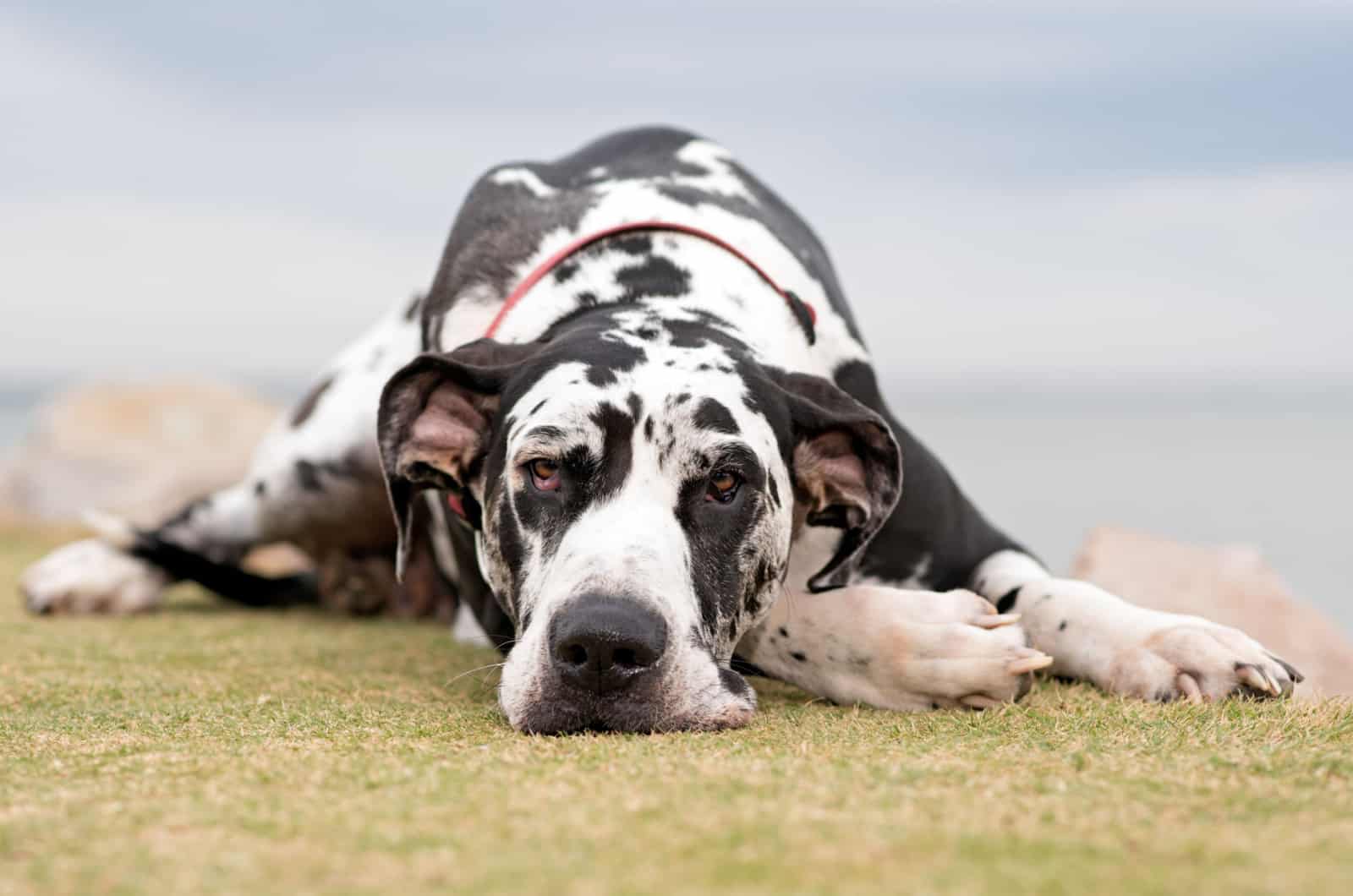
The Harlequin Color is specific and makes a Merle Great Dane unique. But there is not just one version of color patterns that Harlequin comes in.
The normal Great Dane puppies will typically turn up to be black or brindle Great Danes as adults. A genetic flaw known as brindle causes the coat to be striped or multicolored.
These beautiful dogs are specific for their graceful appearance and elegant posture. Almost as if these large dogs are the royalty among the dog kingdom.
Having this in mind, it is not the tiniest bit unusual that these big dogs are often represented on big screens. Their gracefulness and powerful, yet elegant appearance makes them a camera-loving dog.
Do Merles Come In Different Colors?
Yes, Harlequin Great Dane has different colors of Merle.
Aside the white base coat and black spots, they can have pigments of other colors such as:
• fawn (the rarest)
• brindle
• blue
It is hard to decide which color suits these beautiful dogs the best. But the dog breeders, when preparing for a show, usually pick out the ones which have white necks, because it is considered as a preference in this breed standard.
The blue Great Dane somehow appeared to be the one which is the most suitable to breed with a merle Great Dane. Why? Because somehow, it appears that at least 30% of the litter will inherit the harlequin pattern. How? Who knows.
Famous Harlequin Great Danes
You maybe didn’t know this, but the dog from the famous Scooby doo cartoon was actually a Great Dane! And also, he is a Harlequin! Having a brown to hazel coat with a few black spots makes him qualified to be a Harlequin.
The Scooby Doo’s posture probably wouldn’t win any dog shows because he did appear a bit smaller and less graceful, but nevertheless, the cartoon made an impact on people’s interests of this breed.
These dogs have appeared in numerous Hollywood movies, Music videos, commercials, and are owned by a lot of celebrities.
They are not celeb favourites without a reason-their temperament and personality in together with their looks makes the perfect combination of gentleness and robustness.
Deceiving Look: Gentle Giants
Despite their enormous size (check the Great Dane growth chart to find out more!), Great Danes are gentle and extremely sensitive. A famous Great Dane named Zeus claimed the distinction of “tallest dog in the world.”
This gentle giant is athletic, with a well-toned, muscular body, and has a royal demeanor. They were raised by Germans of high birth, so the argument is not implausible.
Another loving epithet for Great Danes is “Apollo of Dogs.” These dogs are big, strong, and gifted with such a strong, honorable attitude, somewhat like Apollo, the Sun God!
Even if they may look as if they could fight anyone or anything, which they can, they are on the peaceful side-they do not really fit into the category of an aggressive dog.
Unlike labrador retrievers, who often when feeling anxious, can bite or nibble their owners, this dog breed is always calm and collected, therefore they carry the title of the Gentle Giants accordingly.
But like pitbulls, the Great Dane is just as great as being a nanny. They love kids and they especially love their families, and are loyal to death.
Does The AKC Approve The Harlequin Great Dane?
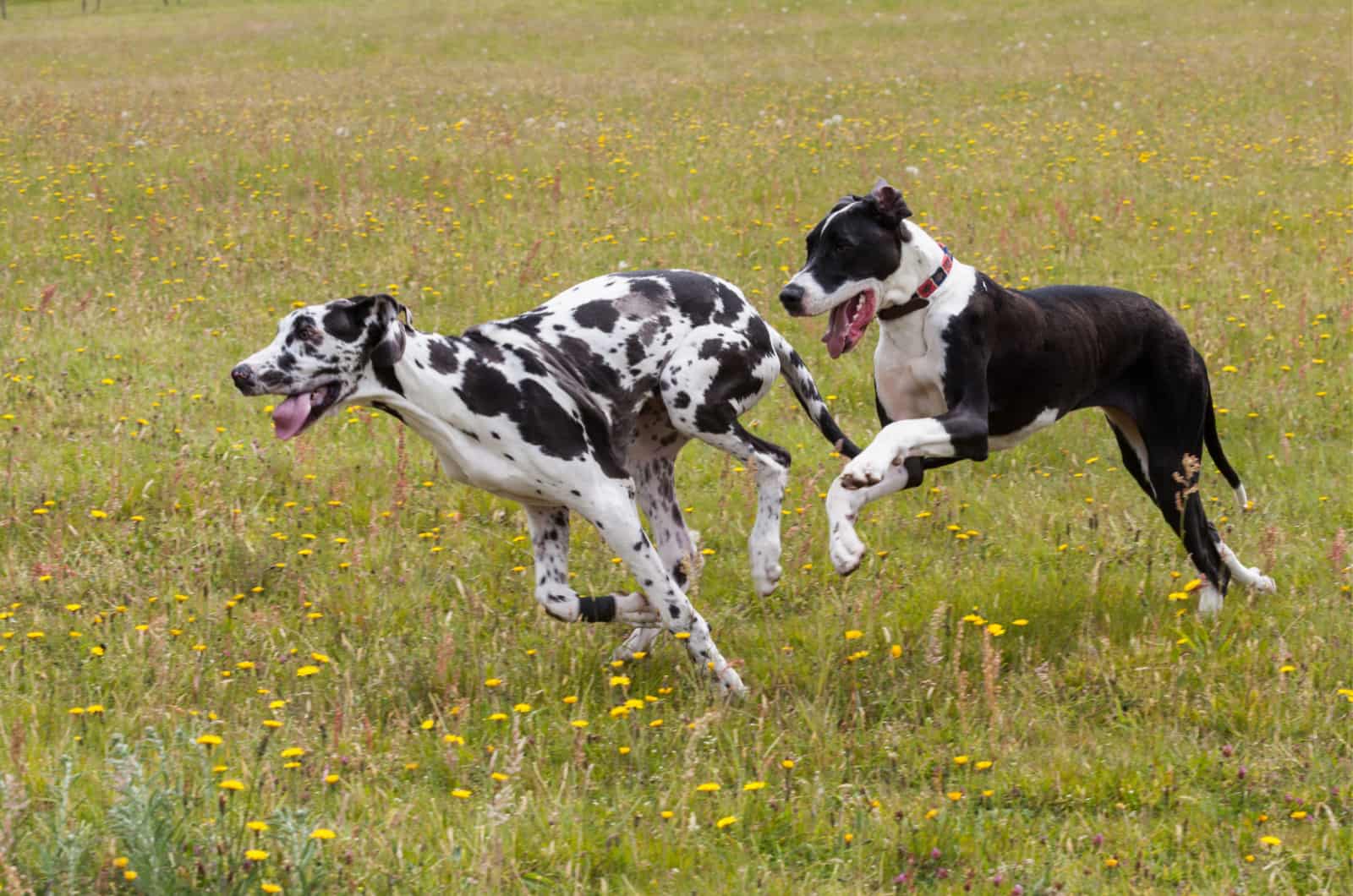
Yes, most definitely-the American Kennel Club approves of the Harlequin Great Dane. They are more than welcomed in the AKC, as equally as any other coloured Dane.
AKC approved the Great Dane as a dog breed a long time ago, in 1887. I mean, who wouldn’t approve of these unique, majestic and beautiful dogs? They are anything but ordinary!
The Great Dane is a large dog that stands 28 to 32 inches tall and weighs between 110 and 175 pounds. The Harlequin Great Dane has the additional peculiarity of having a gorgeous and distinctive coat.
The American Kennel Club’s breed specification describes that Harlequin Great Danes should have black or spotted ears, a white neck, and a coat that is predominantly white with black spots or “patches”.
Additionally, the coat may have various sizes and shapes of gray spots or patches.
Any color variation that deviates from these specifications may be criticized or disqualified for showing, in accordance with the American Kennel Club’s breed standard for show-quality Harlequin Great Danes.
The Great Dane Club of America was established in 1889, yet we don’t know when or even where the first Great Danes were imported into the US. It was the fourth breed group that the American Kennel Club had approved for membership.
What Kind Of Personality Do Harlequin Great Danes Have?
Danes are cautious home guardians despite their pleasant disposition. Usually, the mere sight of these gentle giants is enough to frighten invaders.
However, those who are foolish enough to mistake the breed’s friendliness for softness will come up against a worthy opponent who exhibits true courage and energy. Danes are friendly, people-pleasers, and patient with children.
They need to be properly brought up from a young age, since this breed is very intelligent and mostly self-willed.
They are not the type of dog that will bark on anything or anyone who passes by, but are excellent for detecting true danger using their instincts. So if they bark at someone or at something, you should definitely check out what your dog is alerting you about.
Sometimes these dogs are not aware of their size. They are the type of dog that will randomly just come and sit on your lap while you’re watching TV, and they are not the tiniest bit aware of their weight or height. There isn’t a single couch that they cannot fit in.
Maybe it’s not that obvious, but they consider themselves as a lapdog, therefore you have to buy a pretty big couch.
As I have previously mentioned that they are not aware of their size, while your kids are small, you should pay attention when they are playing. While the kids and the great Dane run around, the great thing could possibly, yet unintentionally, push someone.
Other than that I find the great Danes the perfect family dogs. They are the perfect mixture of elegance, courage, friendliness and joyfulness.
Importance Of Early Socialization
Socialization is also highly important as in any other dog breed. It is of great benefit to start socializing them early on. When you finish their first shots, and as they are ready to explore the outside world, start the process of socialization with other dogs so as with other people.
Every dog breed is needed to be brought up and trained according to their personality and intelligence. There isn’t an exception to this rule, because if so-you will probably end up with a disobedient dog.
Harlequin Great Dane Health
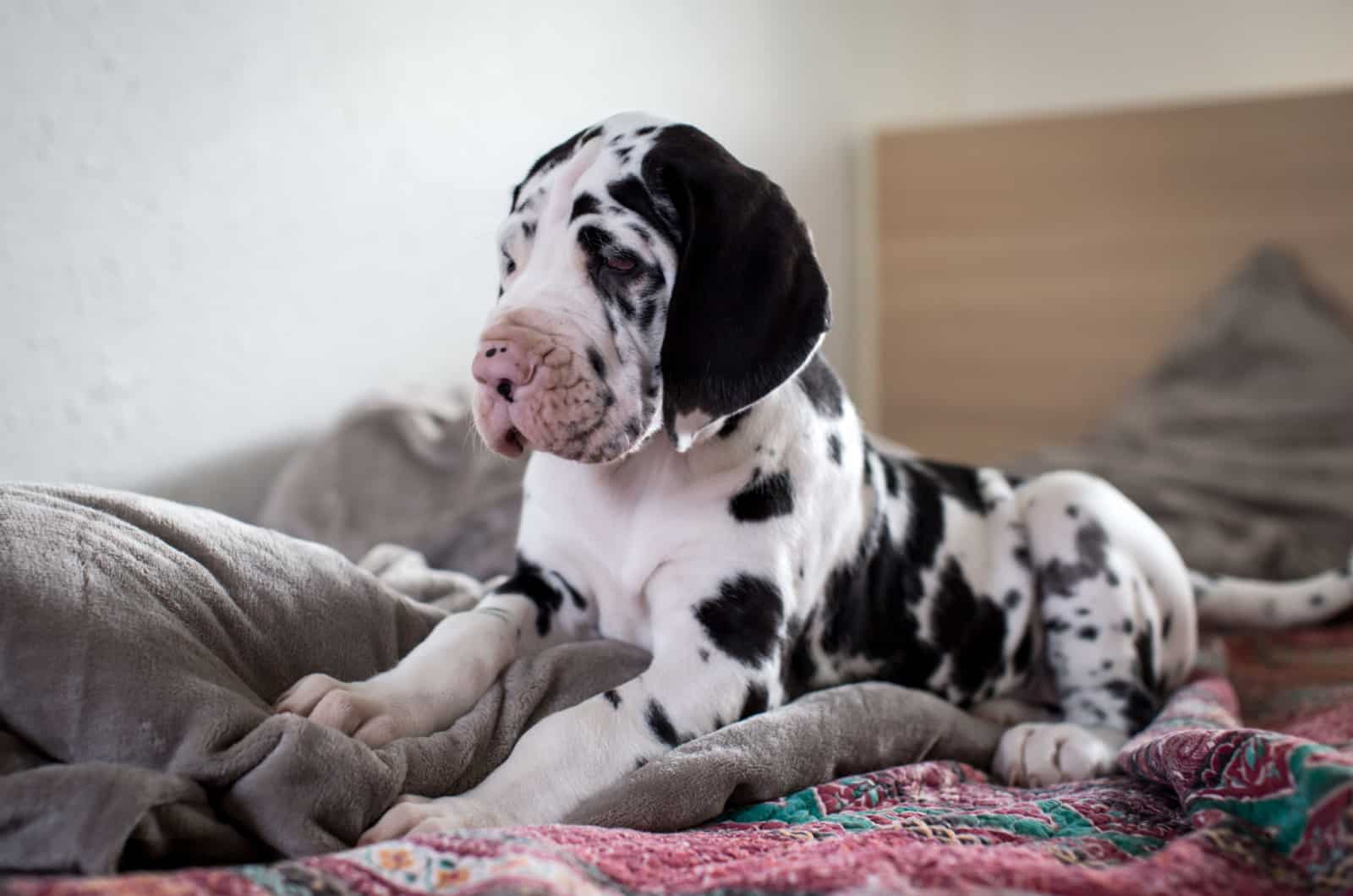
Gastric dilatation-volvulus (GDV), commonly known as bloat, is the most common cause of death in Danes. Owners should become acquainted about the warning indications of bloat and what they should do when it occurs.
An operation called a prophylactic gastropexy, commonly known as a “preventative tack,” is routinely considered by breeders and owners as a way to avoid some of the more severe GDV effects.
In addition to these conditions, the breed is prone to hip dysplasia, hypothyroidism, and autoimmune thyroiditis. Breeding stock is screened by a reputable breeder for ailments that can harm the breed.
We can easily say that you should track your Dane’s health from an early age and have regular vet checks. Also, it is highly important to respond immediately if you see any strange behaviors which indicate to your dog not feeling well.
Also, if you ask me, the biggest disadvantage of this dog breed are not the health problems, but the short lifespan. This beautiful dog breed lives from around 8 to 10 years approximately.
Of course, there are examples which lived for 16 years and more, but unlike small dogs, unfortunately, our beloved Danes have a short lifespan.
Should You Get A Harlequin Great Dane?
Who in this world would be able to resist the cuteness of Harlequin Great Dane puppies? Don’t be fooled by their looks while they are puppies. They will absolutely grow into big dogs.
Every dog owner knows that it is important to raise your dog right and to train it from an early age. This breed is no exception. With a balanced diet and regular exercise, these gentle giants would make a perfect family dog. They are a good fit for both lazy and active-lifestyle families.
Even while the majority of Great Danes get along well with kids, they can easily and unintentionally knock down a young child. In every situation involving dogs and kids, adult supervision is required.
You need to pay regular visits and checks with your veterinarian. This doggy needs your attention at all times, and in return, they will give you the best experience of owning a dog.
They look pretty intimidating, which is the flip side of this. A person is likely to flee the area before even entering if they encounter a dog that is taller than them, standing on its hind legs, and flexing its muscles as it growls a warning.
They benefit from the connection they have with their family. Therefore, they will respond quickly if they believe that anything or anyone is in danger. Along with defending the house, they will show their allegiance in less significant circumstances.
